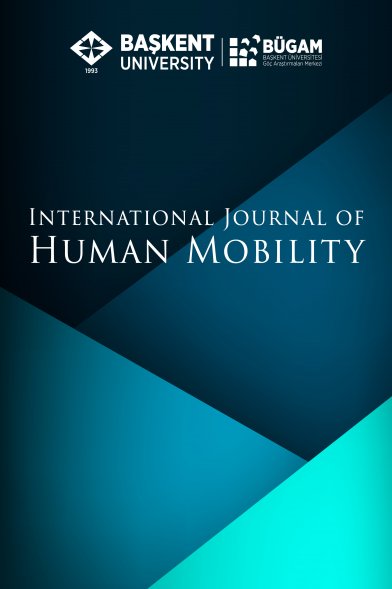Göçün Seçilmiş İktisadi Etkileri: Pozitif ve Normatif Açıdan Bir Değerlendirme
Bu çalışmanın amacı, göçün seçilmiş iktisadi etkilerinin pozitif ve normatif olarak ayrıştırması gerekliliğini
göstermek ve bu ikisi arasındaki seçimin nasıl yapılabileceğini tartışmaktır. Bu amaca ulaşmak için betimsel analiz
yöntemi kullanılarak önce pozitif ve normatif iktisat arasındaki fark açıklanmış, sonra, pozitif ve normatif iktisadın
göç ile bağlantısı kurulmuştur. Daha sonra, pozitif iktisat bağlamında; matematiksel olarak büyüme muhasebesi
açıklanmış ve göçün büyüme oranı üzerindeki etkileri saptanmış, ardından, Lewis modeli ve demografik fırsat
penceresi üzerinden göçün etkileri tartışılmıştır. Sonrasında, aslında pozitif iktisat kapsamındaki çalışmalardan
olan Hirschman’ın (1958) ve Rybczysnki’nin (1955) çalışmalarına dayanarak normatif iktisat bağlamında çıkarımlar
yapılmıştır. Çalışmanın sonuçlarına göre, göçün pozitif iktisat bağlamındaki etkileri incelendiğinde, en azından,
göç edenlerin işgücü başına sermaye büyümesi üzerindeki etkisi, göç edenlerin verimlilik büyümesi üzerindeki
etkisi, göç edenlerin işgücü büyümesi üzerindeki etkisi, göç edenlerin işgücü başına sermayenin marjinal ürünü/
işgücü başına sermayenin ortalama ürünü üzerindeki etkisi, göçün sınırsız emek arzını çoğaltan etkisi ve göçün
demografik fırsat penceresinin kapanma süresini geciktiren etkisi araştırılmalıdır. Bir diğer sonuca göre, göçün
etkileri yalnızca göçün getirileri üzerinden pozitif bir yaklaşımla incelendiğinde, günümüzün kalkınma iktisadının
temel kavramları olan insani gelişme ve kapsayıcı büyüme perspektifinden konuşulmamış olacağı için göçün
etkileri pozitif ve aynı zamanda normatif olarak ele alınmalıdır. Bu doğrultuda, göçün pozitif ve normatif olarak
ayırt edilen etkilerinin nasıl seçileceğinin tartışılması için Hirschman’ın çerçevesi kullanıldığında şu sonuç elde
edilmiştir. Öncelikle normatif bir bakış açısından hareket edildiği taktirde, bu sayede çoğalacak olan iktisadi
kaynaklar ekonominin büyümesini sağlayacak ve pozitif yaklaşımın getirisini mümkün kılacaktır. Tersine,
öncelikle pozitif bir bakış açısından hareket edildiği taktirde, bu sayede ortaya çıkacak olan gelir artışı normatif
yaklaşımın finansmanını mümkün hale getirecektir.
Selected Economic Effects of Migration: An Assessment from Positive and Normative Perspectives
The aim of this study is to show the necessity of separating the selected economic effects of migration as
positive and normative and to discuss how the choice between the two can be made. In order to achieve this
aim, using the descriptive analysis method, first, the difference between positive and normative economics is
explained, and then the connection between positive and normative economics and migration is established.
Then, in the context of positive economics, growth accounting is explained, and the effects of migration on
the growth rate are determined mathematically. Then the effects of migration are discussed through the Lewis
model and the theory of demographic transition. Afterwards, inferences were made in the context of normative
economics based on the studies of Hirschman and Rybczysnki, which are actually studies within the scope of
positive economics. According to the results of the study, when the effects of migration in the context of positive
economics are examined, at least the effect of immigrants on capital per labour growth, the effect of immigrants
on productivity growth, the effect of immigrants on labour force growth, the effect of immigrants on the marginal
product of capital per labour / average product of capital per labour, the effect of immigrants on increasing the
unlimited labour supply and delaying the closing time of the demographic window of opportunity, should be
investigated. According to another conclusion, since the basic concepts of today's development economics are
normative, if the effects of migration are examined with a positive approach based on only returns of migration,
the normative effects of migration will not be discussed. Accordingly, when using Hirschman's framework to
discuss how to select the positive and normative effects of migration, the following result was obtained. First
of all, if we act from a normative point of view, the economic resources that will increase in this way will ensure
the growth of the economy and make the return of a positive economics approach possible. On the contrary, if
we act from a positive point of view, the income increase that will emerge in this way will make the financing of
the normative approach possible.
